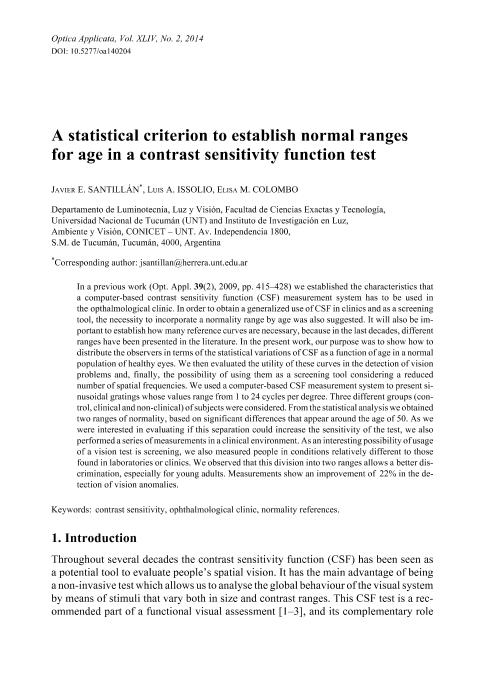Mostrar el registro sencillo del ítem
dc.contributor.author
Santillán, Javier Enrique

dc.contributor.author
Issolio, Luis Alberto

dc.contributor.author
Colombo, Elisa Margarita

dc.date.available
2017-01-26T19:56:30Z
dc.date.issued
2014-03
dc.identifier.citation
Santillán, Javier Enrique; Issolio, Luis Alberto; Colombo, Elisa Margarita; A statistical criterion to establish normal ranges for age in a contrast sensitivity function test; Wroclaw Univ Technology; Optica Applicata; 44; 2; 3-2014; 213-225
dc.identifier.issn
0078-5466
dc.identifier.uri
http://hdl.handle.net/11336/12014
dc.description.abstract
In a previous work (Optica Applicata 39(2)) we established the characteristics that a computer based CSF measurement system has to have to be used in the opthalmological clinic. In order to obtain a generalized use of CSF in clinics and as a screening tool, the necessity to incorporate a normality range by age was also suggested. It will also be important to establish how many reference curves are necessary, because in the last decades, different ranges have been presented in the literature. In the present work, our purpose was to show how to distribute the observers in terms of the statistical variations of CSF as a function of age in a normal population of healthy eyes. We then evaluated the utility of these curves in the detection of vision problems and, finally, the possibility of using them as screening tool considering a reduced number of spatial frequencies. We used a computer-based CSF measurement system to present sinusoidal gratings whose values range from 1 to 24 cycles per degree. Three groups of subjects were considered. Group 1 consisted of 55 subjects grouped in five age ranges: 20-29 (M=25, SD=3.5), 20 eyes; 30-39 (M=34, SD=1.7), 20 eyes; 40-49 (M=44, SD=3.6), 22 eyes; 50-59 (M=55, SD=2.9), 20 eyes; and 60-69 (M=66, SD=2.8), 21 eyes and served as a normal reference and its measurements were performed in a vision laboratory. Group 2 was made up of 29 subjects between the ages of 20 and 50 (M= 32, SD=9.2) who voluntarily attended the Ophthalmology Service of the local Medical School for the first time because they recognized having some difficulty with their vision. Measurements were performed in a consulting room. Group 3 consisted of 56 subjects between the ages of 20 and 50 (M=31, SD=8.1) who were visitors to a Technology Fair, a noisy and visually polluted environment. From the statistical analysis we obtained two ranges of normality, based on significant differences that appear around the age of 50. As we were interested in evaluating if this separation could increase the sensitivity of the test, we also performed a series of measurements in a clinical environment. As an interesting possibility of usage of a vision test is screening, we also measured people in conditions relatively different to those found in laboratories or clinics. We observed that this division into two ranges allows a better discrimination, especially for young adults. Measurements show an improvement of 22% in the detection of vision anomalies.
dc.format
application/pdf
dc.language.iso
eng
dc.publisher
Wroclaw Univ Technology

dc.rights
info:eu-repo/semantics/openAccess
dc.rights.uri
https://creativecommons.org/licenses/by-nc-sa/2.5/ar/
dc.subject
Contrast Sensitivity
dc.subject
Ophthalmological Clinic
dc.subject
Normality References
dc.subject.classification
Otras Ingenierías y Tecnologías

dc.subject.classification
Otras Ingenierías y Tecnologías

dc.subject.classification
INGENIERÍAS Y TECNOLOGÍAS

dc.title
A statistical criterion to establish normal ranges for age in a contrast sensitivity function test
dc.type
info:eu-repo/semantics/article
dc.type
info:ar-repo/semantics/artículo
dc.type
info:eu-repo/semantics/publishedVersion
dc.date.updated
2017-01-24T18:31:30Z
dc.identifier.eissn
1899-7015
dc.journal.volume
44
dc.journal.number
2
dc.journal.pagination
213-225
dc.journal.pais
Polonia

dc.journal.ciudad
Wroclaw
dc.description.fil
Fil: Santillán, Javier Enrique. Consejo Nacional de Investigaciones Científicas y Técnicas. Centro Científico Tecnológico Tucuman. Instituto de Investigacion En Luz, Ambiente y Vision; Argentina. Universidad Nacional de Tucuman. Facultad de Cs.exactas y Tecnologia. Departamento de Luminotecnia, Luz y Vision; Argentina
dc.description.fil
Fil: Issolio, Luis Alberto. Universidad Nacional de Tucuman. Facultad de Cs.exactas y Tecnologia. Departamento de Luminotecnia, Luz y Vision; Argentina. Consejo Nacional de Investigaciones Científicas y Técnicas. Centro Científico Tecnológico Tucuman. Instituto de Investigacion En Luz, Ambiente y Vision; Argentina
dc.description.fil
Fil: Colombo, Elisa Margarita. Consejo Nacional de Investigaciones Científicas y Técnicas. Centro Científico Tecnológico Tucuman. Instituto de Investigacion En Luz, Ambiente y Vision; Argentina. Universidad Nacional de Tucuman. Facultad de Cs.exactas y Tecnologia. Departamento de Luminotecnia, Luz y Vision; Argentina
dc.journal.title
Optica Applicata

dc.relation.alternativeid
info:eu-repo/semantics/altIdentifier/url/http://www.if.pwr.wroc.pl/~optappl/article.php?lp=1143
Archivos asociados
